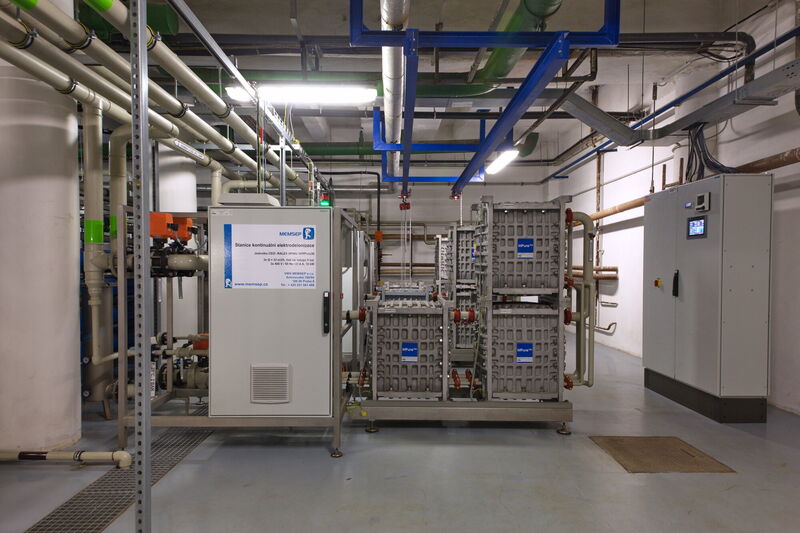Electrodeionization (EDI) is an alternative separation process that replaces conventional ion-exchange demineralization of water on a mixed bed (mixbed). The achievable resistivity of the product is 16-18.2 MOhm/cm.
The separation of ions and low dissociated components from water is achieved by applying a DC (direct) electric current. The ions travel through semi-permeable ion-selective membranes to the electrodes based on their charge. Due to the ordering of the membranes, individual ions are concentrated in certain compartments while desalted permeate collects in other compartments. The spaces between the membranes are filled with a layer of ion exchange, which serves as a carrier to accelerate ion transport. When DC voltage is applied, the electrolysis of water produces hydrogen and hydroxyl ions, which continuously regenerate the ionex.
Electricity consumption is low, typically 0.1 to 0.2 kWh/m³ of product. Unlike conventional technology, EDI is a continuous process that does not require interruptions in operation due to the need for regeneration of the ion exchange. EDI operates at high water recovery (conversion), typically 90 to 95%. The concentrate stream from EDI can, under certain conditions, be returned to the pretreatment process to further increase conversion. Compared to ion-exchange technology, EDI is more demanding for water pretreatment and typically requires upstream one/two-stage reverse osmosis (RO), a combination of RO and softening, or ion-exchange demilination. EDI sets the current trends in water demineralisation and is also a clear choice in terms of environmental impact as it does not require dosing of chemicals that pass into wastewater for operation.
Customer benefits
- Continuous operation
- No recovery chemicals
- Minimum of maintenance
- Low investment and operating costs
Features & Benefits: RO+CEDI system
- Up to three skid-mounted units covering RO, second pass RO and CEDI, with two possible configurations; easily integrated into existing plant, flexibility to respond to different needs
- Lower operating costs than traditional solutions, no chemicals and a smaller footprint
- No regeneration downtime; continuous production of purified water
- Operates with any type of feed water
- Integrated control system with PLC; simplifies operation and maintenance

